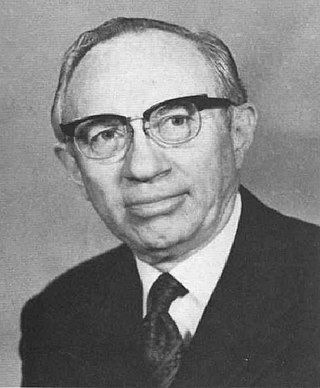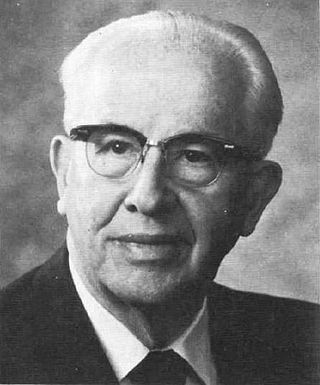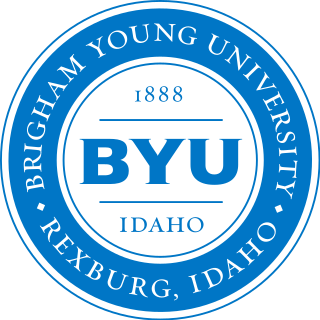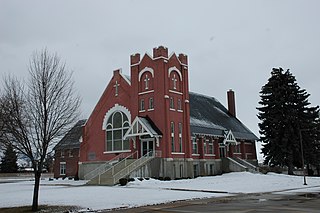
Gordon Bitner Hinckley was an American religious leader and author who served as the 15th president of the Church of Jesus Christ of Latter-day Saints from March 1995 until his death in January 2008 at age 97. Considered a prophet, seer, and revelator by church members, Hinckley was the oldest person to preside over the church in its history until Russell M. Nelson surpassed his age in 2022.

Ezra Taft Benson was an American farmer, government official, and religious leader who served as the 15th United States secretary of agriculture during both presidential terms of Dwight D. Eisenhower and as the 13th president of the Church of Jesus Christ of Latter-day Saints from 1985 until his death in 1994.

Brigham Young University–Idaho is a private college in Rexburg, Idaho. Founded 136 years ago in 1888, the college is owned and operated by the Church of Jesus Christ of Latter-day Saints. Previously known as Ricks College, it transitioned from a junior college to a baccalaureate institution in 2001.

Maeser Elementary was an elementary school in Provo, Utah. It was named after Karl G. Maeser. Built in 1898, it is the oldest school building in Provo, Utah. The school was designed by architect Richard C. Watkins, who also designed the Provo Third Ward Chapel and Amusement Hall, The Knight Block Building, and the Thomas N. Taylor Mansion.

Carthage Jail is a historic building in Carthage, Illinois, listed on the National Register of Historic Places (NRHP). It was built in 1839 and is best known as the location of the 1844 killing of Joseph Smith, founder of the Latter Day Saint movement, and his brother Hyrum, by a mob of approximately 150 men. It was added to the NRHP in 1973 and is operated by the Church of Jesus Christ of Latter-day Saints as a historic site with an adjacent visitors' center.
This is a timeline of major events in Mormonism in the 20th century.

The Church Educational System (CES) of the Church of Jesus Christ of Latter-day Saints consists of several institutions that provide religious and secular education for both Latter-day Saint and non–Latter-day Saint elementary, secondary, and post-secondary students and adult learners. Approximately 700,000 individuals were enrolled in CES programs in 143 countries in 2011. CES courses of study are separate and distinct from religious instruction provided through wards. Clark G. Gilbert, a general authority seventy, has been the CES commissioner since August 1, 2021.

Leonard C. Brostrom was a United States Army infantry soldier who was killed in action near Dagami, Leyte, Philippine Islands, now the Republic of the Philippines, during the Philippines Campaign of 1944–45, in World War II. He received the Medal of Honor posthumously for his heroic actions above and beyond the call of duty. Brostrom was a member of and served a mission for the Church of Jesus Christ of Latter-day Saints before he entered the Army.

The Brigham Young Complex is a collection of buildings historically associated with the second President and leader of the LDS Church Brigham Young, on East South Temple in the center of Salt Lake City, Utah.

Nauvoo Historic District is a National Historic Landmark District containing the city of Nauvoo, Illinois. The historic district is nearly coterminous with the City of Nauvoo as it was incorporated in 1840, but it also includes the Pioneer Saints Cemetery, the oldest Mormon cemetery in the area, which is outside the town boundary.
Chesterfield is a ghost town in Caribou County, Idaho, United States. It is located in Gem Valley at an elevation of 5,446 feet (1,660 m). The community includes a cemetery and former buildings of the Church of Jesus Christ of Latter-day Saints such as a former meeting house, amusement hall and tithing house.

Historic Kirtland Village is a historic district in Kirtland, Ohio, U.S., owned and operated by the Church of Jesus Christ of Latter-day Saints. The district is made up of buildings and sites important to the early Latter Day Saint movement. Some of the buildings are original and have been restored to their 1830s appearances, while others were rebuilt on or near their original sites.

The Malad Second Ward Tabernacle is a tabernacle and meetinghouse of the Church of Jesus Christ of Latter-day Saints located in Malad City, Idaho. It is significant for its large scale and unorthodox adaptation of architectural styles, as well as its historical importance to Oneida County, which once was among the most populated counties in Idaho. It is, along with six other buildings in Oneida County, listed on the National Register of Historic Places.

The Bear Lake Stake Tabernacle, or Paris Tabernacle is situated on main street in Paris, Idaho, is a Romanesque red sandstone meetinghouse of the Church of Jesus Christ of Latter-day Saints designed by Joseph Don Carlos Young, the son of Brigham Young built between 1884 and 1889. The tabernacle was built by Mormon pioneers of Bear Lake Valley who used horse and ox teams to haul rock quarried from Indian Creek Canyon nearly 18 miles away. After the completion of the Logan Utah Temple in 1884, the workers began construction of the tabernacle. William Budge supervised the construction. It cost $50,000 to build and seats around 2000 people.

The Blackfoot LDS Tabernacle, also known as the Blackfoot Tabernacle or South Blackfoot Stake Tabernacle is a building located in Blackfoot, Idaho that formerly served as a tabernacle for large gatherings of members of the Church of Jesus Christ of Latter-day Saints. The tabernacle was designed by architects Hyrum Pope and Harold W. Burton and completed in 1921. The building was listed on the National Register of Historic Places in 1977. In 1980 the church sold the building to the city of Blackfoot. It was used as a civic auditorium until the 90's and sat until 2003. In 2003 local business owner Perry Hawker bought it and it now functions as the Hawker Funeral Home.

Tithing buildings of The Church of Jesus Christ of Latter-day Saints are storehouses related to tithing by members of the Church of Jesus Christ of Latter-day Saints.

The Smithfield Tabernacle is a historic Church of Jesus Christ of Latter-day Saints (LDS) tabernacle and present-day recreation facility in Smithfield, Utah. It is one of 42 surviving LDS tabernacles out of 92 built. The building was a notable construction for a settlement of Smithfield's size, and it served as a geographic and symbolic center for the early town, functioning as an important religious and public space.


















